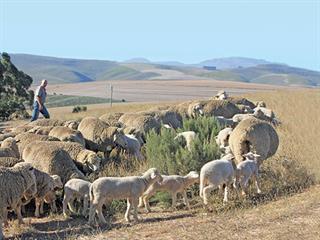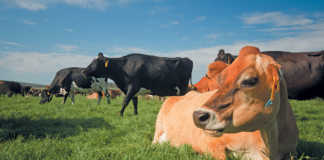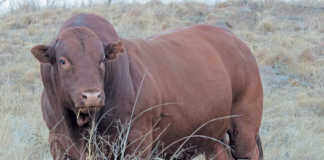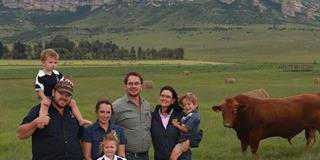
“It all boils down to hard work and strict selection focused on fertility.” This, according to Michael Swart of Swartrivier Estate near Caledon, has been the cornerstone of the Swarco Dohne Merino Stud’s success. And the hard work he hints at is not just the physical labour of working with the sheep; it’s years of research, disciplined teamwork and constant maintenance of the highest standards as a breeder.
Accolades
The Swarco stud has twice been named the Top Dohne Breeder for the southern region and received the Virbac award for top Dohne Breeder in South Africa in 2004. The stud takes part in the National Auction and the Caledon and Mossel Bay sales. And for the past 14 years (this year will be the 15th), the Swart family has held an on-farm production sale, where they often earn the top price paid for a ram and the highest average price per ram at a production auction.
Switching from Merino to Dohne
Originally a Merino breeder, Michael says he was never fully satisfied with the returns they achieved or the type of rams that were available on the market. In the early 1980s, he decided to start a Dohne Merino flock and run it parallel to the Merinos so that he could compare performance differences between the two breeds.
“Part of the Merino flock was kept pure and we recorded the comparative productivity of the Dohne flock,” he recalls. By the early 1990s, the superiority of the Dohnes was clear and the Merino flock was sold, providing the capital to invest in a Dohne stud. “It was obvious that the Dohnes utilised the veld in our environment better than the Merinos did. Their lambing percentage, and as a result our income, was higher,” he explains.
As fate would have it, at the time when they decided to switch to Dohnes, three top Dohne studs were being offered for sale. In August 1991, Michael bought the Drostersnes Stud in Malmesbury, in February 1992, he bought the André van der Merwe’s Lighuis Stud from Humansdorp, and in October 1992 he purchased the Jacnic Stud owned by Nikola van der Westhuizen of Loxton.
The business today
The Swarco Stud maintains about 500 ewes and the commercial flock has about 2 500 ewes and their followers. The sheep are kept in camps of roughly 25ha each, on a total area of 1 300ha, half of which is cropped and half sown to pasture.The Swart family welcomes visitors to their farm with warm hospitality and the business is run as a close-knit family enterprise with a commitment to excellent staff relationships and teamwork.
Michael’s son Pieter is in charge of the cropping.He subscribes strictly to beneficial farming practices such as precision farming, minimum till, crop residue preservation, and irrigation scheduling that avoids over-irrigation. The Swarts produce small winter grains in rotation with pasture crops and vegetables such as pumpkins and onions.
Japie Hamman, the Swarco Stud manager, doubles as a farm manager and is also responsible for keeping the stud records. Michael attributes a great deal of the success of the Swarco Stud to Japie’s dedication and expertise.
Michael’s wife, Marina, and their daughter, Liza-Mari, run the farm office.
Stud Management
In the beginning, laparoscopic insemination and embryo transplants were used to speed up the process of breeding top quality animals. Nowadays, however, the Swarts use their own rams as well as bought in rams to provide genetic variety. Michael spares no expense in getting the best rams he can find. “We practice supplementary feeding so lambing seasons must fit in with our farming methods,” says Michael. “To get the sheep on the sale at between 16 and 20 months breeding is tied to certain dates.”
Swarco Stud ewes lamb once a year in two groups either in September or in January. The lambing rate is about 150% and the weaning rate is 135%. At the last production sale, 75% of the rams offered were from multiple births. Careful records are taken at lambing of cull defects and any faults that might not be evident later on. Lambs are shorn at four months shortly after lamb classing and then again at 12 months when they are performance-tested.
Young sheep receive light grain and energy supplementation, the target weight for rams being 60kg to 65kg at 12 months and 90kg to 95kg at marketing. Michael believes their clear client-orientated commercial objectives, and the transparency with which management and selection programmes are applied have contributed to their success.
“We follow a strict selection regime with the rams,” he says. “Just prior to shearing, at 12 months, rams are classed visually and almost half are culled. After final inspection, only the best are retained as breeding material to be offered on the various sales, the most important of which is the on-property sale that takes place in May every year.”
Mating dexterity
Since they started the Swarco Dohne Stud, Michael has been determined to ensure the rams they supply are not only of superior genetic merit, but fertile, fit and ready to mate. To qualify to be offered on auction, rams have to pass a number of tests, which include a second fibre diameter test, a genital soundness test, and a libido and mating dexterity test carried out by a vet.
“Rams that fail these tests are not put up for sale. That’s part of the client service guarantee that we offer,” says Michael.
In the months leading up to the sale, rams are exercised daily to ensure that they will adapt, that their feet are sound and that they are ready to serve. With the emphasis on fertility, it is Michael’s ambition to eventually offer only rams born as multiples.
He explains that one aspect that sets Swarco apart from many other stud breeders is the emphasis they place on mating dexterity testing.
“When we first started doing this type of testing, a number of our rams failed to make the cut. But because we have consistently selected only rams with proven mating dexterity, most of the rams evaluated these days pass the test,” he says. “In a commercial flock, it’s not as easy to pick up on the lack of mating dexterity in any particular ram. If a farmer puts three or four rams in with a group of ewes, he’ll probably not notice if one of the rams fails to do his job. Over time, however, this can result in substantial losses.”
Ideally, mating dexterity testing should be compulsory, because, as Michael points out, just because a ram is fertile, it does not mean that he will mate.
Careful wool selection
The Swarts have maintained strict selection for wool quality. Their three-year average fibre diameter for the stud is 19,1 micron. The average fibre diameter of sheep offered for sale at the 2013 auction was 18,79 microns for 16-month-old animals and 18,89 microns for 20 month animals. Michael feels strongly that stud breeders should provide prospective buyers with micron values measured at 12 months, and values measured just before the auction.
“For some rams, the micron value can strengthen by up to a micron-and-half from 12 months to auction age. Buyers should insist on access to 12-month and auction-age micron values,” he says. The selection focus on wool quality is complemented by a high level of reproduction and lamb growth rate in the stud – indicative of true dual-purpose sheep – explains Michael.
Interestingly, the relationship of fleece to body weight (WPP%) for all stud animals offered for sale at the 2013 auction was at an optimum level of 5,8% to 7,5%. “We believe we offer some of the safest rams available healthwise, thanks to years of co-operation with our vets, Ian Herbst and Hilda Retief,” says Michael.
Lambs are dosed with anthelmintics for the first time at six to eight weeks and follow-ups are given every four weeks. Older sheep are dosed at fixed periods – for example, before mating and lambing. Dosages are determined by a vet on the basis of dung samples and faecal worm egg counts.
Commercial flock
The commercial flock at Swartriver is a model of productivity. Ewes in the commercial flock lamb three times in two years. The average weaning rate for the commercial flock is about 135%. Lambs are marketed at weaning when they are three-and-a-half to four months old. The majority qualify as prime slaughter lambs with live weights in excess of 36kg.
Better, not bigger
Farming operations are growing in size as farmers try to benefit from economies of scale, but the Swarts are bucking the trend.
“We research continually to find better ways of doing things. Instead of going bigger by buying in more land we decided to make the best of what we have by increasing our farming efficiency,” says Michael. They are achieving this through strict selection, which has increased the productivity of their stud and commercial flocks and by experimenting with and implementing smart rotation cycles that utilise the land and water that they have available optimally.
Phone Michael Swart on 028 212 2407 or email [email protected].













